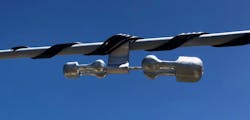Put a Damper on Wildfires with Vibration Mitigation
Overhead electrical distribution lines are traditionally constructed with bare aluminum or copper conductors energized at thousands of volts. This presents a danger to people and wildlife from possible direct contact with the line or indirect consequences resulting from electrical short circuits. An alternative is to use covered, or jacketed, conductors to prevent incidental earth or phase-to-phase faults caused by fallen trees, high winds or other natural events.
Covered conductor has a long and varied past regarding durability and reliability. However, after recent material improvements and enhancements in environmental performance, it has gained popularity, primarily because of its effectiveness in preventing open electrical arcing in fire-prone environments. The process of covering the energized conductor with a dielectric material greatly reduces the possibility of external objects causing electrical shorts that start fires. This reduction in fire-related incidents makes covered conductor used in standard construction viable, cost effective and beneficial in almost any application.
Because of its effectiveness, Southern California Edison (SCE), which serves approximately 15 million Californians within a 50,000-sq mile (129,500-sq km) service area, has deployed covered conductor as a keystone of its wildfire mitigation plan. SCE’s wildfire covered conductor program involves replacing existing bare wire with covered conductor in high fire risk areas. As of February 2022, SCE has installed approximately 3000 circuit miles (4828 circuit km) of covered conductor throughout its territory.
Although covered conductor offers many benefits, one important aspect of its performance must also be considered: vibration. While damper applications for bare-wire systems have been studied heavily by the industry, the opposite is true for vibration dampers on covered conductor systems. SCE began assessing the need for vibration dampers on covered conductor systems from 2019 to 2020. While the evaluation was in process, the utility began noticing sporadic cases of aeolian vibration occurring on its covered conductor installations.
Vibration Dampers
In two specific instances, SCE was made aware of aeolian vibration through customer noise complaints. The vibration was causing dead-end wildlife covers to clatter against the covered conductor. To address the issue, SCE contacted damper manufacturers for assistance, and Preformed Line Products (PLP) responded to help SCE further understand the effects of aeolian vibration on covered conductor systems.
PLP and SCE already knew that under smooth, low-velocity (2-mph to 15-mph [3.2-kmph to 24.1-kmph]) wind conditions, overhead conductors, overhead shield wires and optical ground wire can vibrate at a range of frequencies. Although the amplitude of this conductor movement is low (less than one cable diameter), the accumulation of vibration cycles over a long period of time can lead to fatigue damage or failure of the conductor strands through fretting, wherein individual aluminum or steel conductor strands rub together and remove material from one another.
In the case of covered conductor, unmitigated aeolian vibration can also cause damage to the conductor jacket. In turn, this damage degrades the life of the line and reduces the effectiveness of the conductor’s covering. Due to its smooth surface, covered conductor may be more susceptible to aeolian vibration than bare conductor, which has exposed individual strands that can somewhat help to break up the wind flow.
To address the issue of vibration on covered conductor systems, SCE and PLP worked together for approximately 18 months to develop damping products, placement recommendations and standards specific to covered conductor installations. Proper interfacing and compatibility with the covered conductor were vital considerations. SCE and PLP agreed the damping devices should be installed directly over the conductor jacket and not require any stripping or removal. Because the jacket is part of the conductor system, any damage to it through installation or long-term use of the damper would be considered detrimental to the life of the system.
Conductor Size
For smaller conductors, 0.872 inch (22.2 mm) and under, PLP employed its Spiral Vibration Damper (SVD). Made from an extruded polyvinyl chloride (PVC) rod, the SVD is an impact-style damper that wraps loosely around the conductor. When the conductor begins to vibrate, it contacts the SVD, which has enough weight and length to knock the conductor out of vibration resonance, regardless of wind speed or frequency. The SVD has been used on bare cable applications for several decades. In addition, because it is made of PVC, the SVD had no issues interfacing with the covered conductor’s cross-linked high-density polyethylene outer layer.
As the diameter and weight of the conductor increase, however, the length and weight of the SVD must also increase. At a certain point, the SVD size required becomes too long to be installed safely. Therefore, conductors with large diameters need a different damping solution. For SCE, PLP used its Stockbridge-style VORTX Vibration Damper to address vibration on conductor diameters greater than 0.872 inch.
The VORTX Vibration Damper functions by translating the conductor’s movement through a clamp, galvanized steel messenger wire and weight system. When the conductor moves, this causes movement of the damper weights, which then causes bending in the galvanized steel messenger wire. The bending of the messenger wire combined with the movement of the weights dissipates vibration energy through friction.
New Attachment Method
To use the VORTX damper on covered conductor, however, PLP had to develop a new attachment method. Traditionally, an aluminum clamp is directly bolted to the bare conductor and torqued per the specification, but damage to the conductor jacket puts the entire conductor system at risk. Early in the development phase, PLP’s testing confirmed that when a standard bolted clamp was used, the clamp severely deformed the conductor jacket, causing concerns about the jacket tearing over time.
During testing, PLP also noted the conductor jacket deformation led to rapid residual torque loss, which raised concerns about the damper loosening over time and causing damage to the conductor. To address this concern, PLP worked together with SCE to develop a system that would protect the conductor jacket and comply with SCE’s requirements for flammability mitigation.
SCE’s solution involved using PLP’s helically attached VORTX damper, which has a semi-conductive elastomer-lined clamp and special semi-conductive plastic-coated rods, to distribute clamping forces over the helical attachment, ensuring electrical compatibility between the damper and conductor.
Like other Stockbridge-style dampers, the VORTX damper is sized and tuned to damp a range of mechanical impedances, or how much the conductor resists motion when subjected to a harmonic force like aeolian vibration. For bare conductor, mechanical impedance is easily correlated to a linear relationship between conductor diameter and weight. The damper is selected based on the conductor diameter and, through impedance matching, dissipates the conductor motion. However, because of the jacket increasing the conductor’s overall diameter but having less of an effect on the conductor’s weight, determining a covered conductor’s mechanical impedance is much more difficult. In turn, this makes sizing and positioning the Stockbridge damper system a tougher task than on bare conductor.
Field And Lab Testing
SCE and PLP agreed a field evaluation would be instrumental in determining the severity of the vibration issue and effectiveness of the new vibration system. Two field vibration studies were performed.
The first vibration study was performed in 2019 on an in-service 12-kV line in Hemet, California. The area was chosen because of its accessibility and position on open terrain, which increases the likelihood of vibration occurring on the line. For this field evaluation, SVDs were placed on 15-kV 1/0 conductor. PLP worked with SCE to determine appropriate test sites for this study.
Vibration recorders were installed near the two poles of one span to monitor the inverse bending amplitude (the conductor bending relative to the recorder) of the conductor in motion. The vibration recorders used a moment arm to measure the amplitude and frequency of the conductor motion at set recording intervals over a two-week time frame. After two weeks, SCE took down the recorders and returned them to PLP for data processing. The results demonstrated the measured strain levels of both the damped and undamped spans were higher than the safe strain limit for bare aluminum conductor steel-reinforced (ACSR) conductor, but the SVDs reduced vibration levels and fatigue cycle accumulation significantly.
A second study was performed in late spring of 2020 in Menifee, California, to measure the performance of the VORTX Vibration Damper on a 12-kV 336.4-kcmil ACSR covered conductor. (PLP provided support for this study remotely because of COVID-19 travel restrictions.) The same study methodology was performed over a two-week time frame. This study found the VORTX Vibration Damper reduced the accumulation of high-amplitude vibration cycles and, as a result, reduced the amount of damaging vibration activity, especially at high frequencies.
Information from these studies prompted PLP to perform additional laboratory testing to affirm damper placement philosophies. It was determined — because of the weight vs. conductor disparity noted previously and the various tensions used in SCE’s distribution footprint — two VORTX Vibration Dampers, installed near one end of the span, would be needed for the utility’s covered conductor systems. This configuration would ensure adequate coverage across the conductor’s resonant vibration frequencies. PLP used span and design tension data to produce general placement recommendations for standard SCE construction, so field crews would have clear guidelines when installing the dampers.
Vibration Damper Standard
SCE used the damper placement data PLP collected to conduct additional tension assessments, so it could write a vibration damper standard for its covered conductor applications. The utility’s covered conductor standard was published in the fourth quarter of 2020.
After publication of the standard, SCE assessed the need for a vibration damper retrofit program on covered conductor installed prior to the new standard. Using terrain and wind conditions, SCE conducted analysis to determine the vibration susceptibility of its covered conductor installations ranging from 2018 to 2020. In addition to the testing conducted to establish the standard, SCE also worked with PLP to develop theoretical calculations on how vibration activity could reduce the estimated life of the line. An estimated lifetime reduction can be calculated by using the captured field vibration data and extrapolating the calculated strain vs. the accumulation of cycles per day.
The vibration susceptibility study and estimated life study were used to determine the target areas and prioritization for vibration damper retrofit work. This retrofit project will proactively mitigate conductor damage caused by aeolian vibration and maintain the expected useful life of SCE’s existing covered conductor lines.
Overall, the collaboration between SCE and PLP was successful in furthering the industry’s understanding of vibration damper applications on covered conductor. By working together, the utility and manufacturer advanced damper designs, placements and rollouts.
With the resulting robust standard and associated rollout plan, these dampers will aid in the success of SCE’s wildfire covered conductor program for years to come.
Arianne Luy ([email protected]) is an engineer for the grid hardening strategy team under wildfire safety at Southern California Edison (SCE). She works with the team to develop strategies for SCE’s wildfire mitigation activities, including SCE’s wildfire covered conductor program. Prior to her current role, Luy was the responsible asset engineer for covered conductor, vibration dampers and underground cable accessories at SCE. She received a BSEE degree from the University of California, Los Angeles.
Niousha Tavakoli ([email protected]) is a T&D asset engineer at Southern California Edison (SCE). She is responsible for vibration dampers and
underground cable accessories in distribution. Tavakoli graduated from California State Polytechnic University, Pomona, with a BSEE degree and is currently pursuing her MSEE degree at the same university.
Ken Akiki ([email protected]) has spent his career at Preformed Line Products (PLP) managing applications for conductor motion mitigation and other cable
anchoring and control hardware. He and his team of product support personnel work with utilities worldwide to develop solutions for complex transmission hardware systems. Akiki is an active member of IEEE and CIGRE. He has a BSEE degree and a master’s degree in engineering management, both from Case Western Reserve University in Cleveland, Ohio.
Mark R. Burns ([email protected]) is the market manager of utility distribution products at Preformed Line Products (PLP). He supports and develops products for the installation, repair and protection of conductors. Burns has 29 years of experience designing and analyzing complex distribution and transmission systems. He began his utility career at Ohio Edison, now FirstEnergy Corp., working in distribution capacity planning and system design. Burns has a BSEE technology degree from The University of Akron in Ohio.
About the Author
Arianne Luy
Arianne Luy ([email protected]) is an engineer for the linear asset engineering team at Southern California Edison (SCE). She is responsible for distribution overhead conductors and underground cable accessories and has been actively involved with SCE’s wildfire mitigation initiatives regarding covered conductors. She received a BSEE degree from the University of California, Los Angeles.
Niousha Tavakoli
Niousha Tavakoli ([email protected]) is a T&D asset engineer at Southern California Edison (SCE). She is responsible for vibration dampers and underground cable accessories in distribution. Tavakoli graduated from California State Polytechnic University, Pomona, with a BSEE degree and is currently pursuing her MSEE degree at the same university.
Ken Akiki
Ken Akiki ([email protected]) has spent his career at Preformed Line Products (PLP) managing applications for conductor motion mitigation and other cable anchoring and control hardware. He and his team of product support personnel work with utilities worldwide to develop solutions for complex transmission hardware systems. Akiki is an active member of IEEE and CIGRE. He has a BSEE degree and a master’s degree in engineering management, both from Case Western Reserve University in Cleveland, Ohio.
Mark Burns
Mark R. Burns ([email protected]) is the market manager of utility distribution products at Preformed Line Products (PLP). He supports and develops products for the installation, repair and protection of conductors. Burns has 29 years of experience designing and analyzing complex distribution and transmission systems. He began his utility career at Ohio Edison, now FirstEnergy Corp., working in distribution capacity planning and system design. Burns has a BSEE technology degree from The University of Akron in Ohio.




